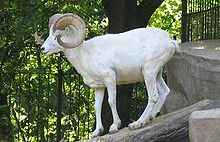Dall sheep
| Dall sheep | ||||||||||||
|---|---|---|---|---|---|---|---|---|---|---|---|---|

Dall sheep ( Ovis dalli ) |
||||||||||||
| Systematics | ||||||||||||
|
||||||||||||
| Scientific name | ||||||||||||
| Ovis dalli | ||||||||||||
| Nelson , 1884 |
The Dall sheep or Alaskan snow sheep ( Ovis dalli ) is a type of sheep that lives in northwestern North America. It is named in honor of the American naturalist William Healey Dall .
features
Dall sheep reach a head body length of 1.3 to 1.8 meters, the tail is very short with 7 to 11 centimeters. At 70 to 110 kilograms, males are significantly heavier than females, who only reach around 50 kilograms. The coat color varies according to the subspecies: In O. d. dalli it is mostly pure white in color, but individual animals can have a black tail or gray spots on their backs. O. d. stonei, on the other hand, is gray-brown or slate-brown in color, the belly and the back of the legs are black. In winter, the fur becomes extremely thick and long.
Both sexes have horns, but these are much thinner than the bighorn sheep . The horns of the females are thin and protrude backwards, those of the males are significantly heavier and larger and turn in over time.
distribution and habitat
Dall sheep live in Alaska and western Canada . In Alaska they inhabit the mountainous regions in the northern, eastern and southeastern parts of the country. In Canada, they occur in the Yukon Territory , in the west of the Northwest Territories and in northern British Columbia . The dark subspecies O. d. stonei lives in the south of the Yukon Territory and parts of British Columbia, the bright subspecies O. d. dalli in the remaining parts of the distribution area.
Dall sheep are primarily mountain dwellers who prefer rocky grasslands. Most populations migrate to lower-lying areas in winter.
Lifestyle and diet
Dall sheep have a well-developed social system. The females live in groups with other females and young animals, they usually behave peacefully towards other females. Only in the case of conflicts about feeding or sleeping places can disputes occasionally arise. The males also live in groups that do not come into contact with the females outside of the mating season. Within the male groups, they establish a hierarchy that is mainly determined by the size of the horns. Often times, dominance is determined without a fight, but when the males have horns of approximately the same size, an argument ensues. The animals attack each other with their heads bowed and often collide from 10 to 12 meters away. Injuries rarely occur due to the thickened skull.
Dall sheep are herbivores. In summer they primarily eat grass and herbs , in winter lichens and mosses make up part of their diet.
Reproduction
When the mating season begins, the males approach the groups of females. Higher-ranking males usually enjoy the mating privilege, but the fights between the males often become more violent. After a gestation period of almost six months, the female usually gives birth to a single young in May or June. After just two weeks, he can start eating solid food for the first time, and at three to five months it is weaned. Females become sexually mature at 2.5 years of age and give birth for the first time at three or four years of age; due to the social system, males do not reproduce for the first time until they are 5 to 7 years old.
Threats
Adverse weather conditions and poor food supply lead to the death of many young animals in particular, plus the dangers of falls and avalanches. Natural enemies of the Dall sheep are wolves , grizzly and black bears , Canadian lynx , wolverines , coyotes and golden eagles .
hunt
The Indians hunted the Dall sheep for their meat and still practice this practice to a small extent today. The hunt is under control of the state wildlife management such as the United States Fish and Wildlife Service in the USA and nonprofit organizations such as the Canadian Wildlife Federation in Canada . Overall, the species is not threatened according to the IUCN .
Systematics
The Dall sheep is one of the five species from the genus of sheep ( Ovis ). It is closely related to the bighorn sheep, which also live in North America, and the Siberian snow sheep , with which it forms the canadensis group.
As mentioned above, two subspecies are distinguished, the lighter O. d. dalli and the darker O. d. stonei . In the past, the animals of the Kenai Peninsula were also listed as a separate subspecies ( O. d. Kenaiensis ), but mostly these sheep belong to O. d. dalli .
literature
- Ronald M. Nowak: Walker's Mammals of the World . Johns Hopkins University Press, Baltimore 1999, ISBN 0-8018-5789-9 .
- Don E. Wilson , DeeAnn M. Reeder: Mammal Species of the World . Johns Hopkins University Press, Baltimore 2005, ISBN 0-8018-8221-4 .
Web links
- Information at Animal Diversity Web
- Ovis dalli in the endangered Red List species the IUCN 2006. Posted by: Caprinae Specialist Group, 2000. Retrieved on 12 May, 2006.


